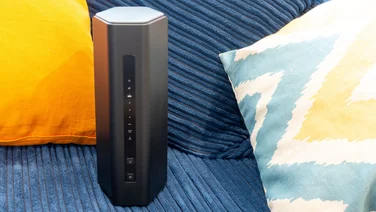To help us provide you with free impartial advice, we may earn a commission if you buy through links on our site. Learn more







- Excellent Wi-Fi speeds
- Multi-gigabit LAN and WAN support
- USB storage option
- Overkill for most people’s needs
- Expensive
Netgear wowed us with its first standalone Wi-Fi 6E router, the Nighthawk RAXE500. It was the fastest wireless router we’d ever tested, but the £550 launch price was a sticking point. Today you can get it for £450, but it’s still a niche product.
The RAXE300 pulls the price down further, while retaining much of the essence of its predecessor. With support for 6GHz Wi-Fi and multi-Gigabit Ethernet, it can provide ultra-fast connectivity throughout the network. There’s also a broad menu of software features, including optional network security and parental control services.
It’s a stretch to call this an affordable router, but if you’re looking for a one-box networking solution (rather than a mesh) then the RAXE300 gets close to the speed and versatility of the flagship RAXE500 for £100 less.
Netgear Nighthawk RAXE300 review: What you need to know
The RAXE300 is a tri-band Wi-Fi 6E router, operating across the 2.4GHz, 5GHz and 6GHz frequency ranges. It will work with all Wi-Fi-certified devices, regardless of their age and radio type, but you’ll get the best performance over Wi-Fi 6 (also known as 802.11ax) or 6E.
For devices connecting on the 2.4GHz band, the RAXE300 offers a theoretical top speed of 600Mbits/sec, while the 5GHz band goes all the way up to 4.8Gbits/sec and the 6GHz network claims a maximum of 2.4Gbits/sec. For physical connections you get five Gigabit Ethernet ports, one 2.5Gbits/sec Ethernet socket and a 5Gbits/sec USB Type-C socket that will take a flash drive or external hard disk.
READ NEXT: The best wireless routers to buy
Netgear Nighthawk RAXE300 review: Price and competition
With a launch price of £350 the RAXE300 is one of the most expensive routers on the market. If you want Wi-Fi 6E, however, you don’t have a lot of alternatives. As we’ve noted, the RAXE500 is even pricier, although it does have a faster 6GHz radio and two USB ports rather than one.
The only other 6E-enabled router we’ve seen so far is the gaming-oriented Asus ROG Rapture GT-AXE11000. We found this wasn’t quite as fast as the Netgear models, however, and at £480 it stretches the budget even further.
There are also a few Wi-Fi 6E mesh options. TP-Link’s Deco XE75 offers a two-station kit for £380; this doesn’t match the top speeds or connectivity features of the Nighthawk, but the distributed design gives it more consistent coverage across multiple rooms, as we’ll see below. Beyond that, Netgear’s Orbi RBKE963 is the current top-of-the-range option for wide-area 6GHz performance, but at £1,500 for the three-node kit it’s not realistic for most homes or offices.
In fact, if cost is a consideration, it’s worth questioning whether you need Wi-Fi 6E at all. While 6GHz connections benefit from reduced interference, a regular Wi-Fi 6 router can still deliver very fast download speeds. In our tests, the Asus ROG Rapture GT-AX6000 put in a strong performance on the 5GHz band, and at £275 it’s cheaper than any 6E option.
Netgear Nighthawk RAXE300 review: Design and features
As with almost all Nighthawk routers, the RAXE300’s antennas are housed inside upturned wings at either side of the casing. This looks quite swish, and the build quality feels nice and solid; the wings fold up smoothly and snap cleanly into place.
While the matte black finish and low-rise body suggest stealth, the size of the router makes it quite imposing. It’s 347mm across the base and 208mm deep; with the wings deployed its highest point reaches 164mm.
This allows space for six Ethernet connectors along the back. Five of these are regular Gigabit ports, of which two can be paired together for an aggregated 2Gbits/sec link; the sixth socket adds 2.5GbE support. You can use this for multi-gigabit broadband, if you’re lucky enough to have it, or connect it to a local device or switch for ultrafast LAN speeds.







The RAXE300 also offers a USB Type-C socket. It’s not the first router to embrace the modern connector standard – the TP-Link Archer AX6000 had a Type-C port back in 2019 – but it’s good to see other manufacturers catching up. However, there’s only one connector here, versus the two Type-A connectors on the RAXE500, and it only works with external storage devices – it won’t take a USB printer or a mobile internet dongle.
Getting set up couldn’t be simpler. As soon as you take the unit out of the box, you’ll see a big sticker on the top detailing the default connection credentials, along with a QR code that you can scan for an instant connection. Network management can then be carried out either from the Nighthawk mobile app or a web portal. These are standard across the whole Nighthawk range, so whichever you choose, the experience is exactly the same as with the RAXE500 and other Netgear routers.
That doesn’t mean the two interfaces are alike. The app has a slick, white-on-black design, while the web interface is plain and sparse. The features are different, too: the app can provide alerts whenever a new device connects to your network and includes a helpful Wi-Fi analytics module, which can track your signal strength around the house and scan for the wireless channels with the least interference.







The optional Netgear Armor and Smart Parental Control services are also controlled from the app. The former provides automatic security scanning and blocking of threats, and comes with endpoint protection software supplied by Bitdefender; the latter does just what you’d expect, letting you set time limits and enforce content filtering for specific devices. After their initial 30-day trials these add-ons are quite pricey, at £85 and £50 a year respectively, but at the time of writing Netgear is offering the first year of Armor for a more reasonable £34.
The web portal is more focused on low-level network settings. This is where you can set up port forwarding, address reservation and USB sharing – you can even enable a DLNA-compliant media server. An incoming VPN service lets you securely access your home network from anywhere in the world.







There are a few boxes left unticked. Netgear’s firmware doesn’t support routing outbound traffic via an external VPN gateway, and there’s no failover option for when your main internet connection goes down. There’s also no easy way to combine multiple units into a mesh. If these things matter to you, an Asus router might be a better fit for your needs – but the RAXE300 is versatile enough for most roles.
Netgear Nighthawk RAXE300 review: Performance
The original Nighthawk RAXE500 boasted 4×4 MU-MIMO and a top speed of 4.8Gbits/sec on both the 5GHz and 6GHz bands. The RAXE300 claims the same numbers for its 5GHz hardware, but on the 6GHz band it offers only 2×2 MIMO, halving the theoretical maximum data rate. Its wings are also around 5mm shorter than those of its forebear, suggesting a slight reduction in the size of the internal antennae.
What does that mean for real-world performance? To find out, I set up the RAXE300 in my study at home, and connected an Asustor Drivestor 4 Pro NAS appliance to its 2.5GbE port. I then took a laptop equipped with an Intel AX210 Wi-Fi 6E wireless card, carried it to various areas of my home, and measured average data rates when copying files to and from the NAS.
I performed the tests twice, once connected to the 5GHz network and again using the 6GHz network. Here are the results I saw, along with those from a selection of competing routers and meshes:


Before getting into comparisons, let’s be clear that we’re looking at an extremely fast router. Over short-range Wi-Fi 6E the RAXE300 can transmit a full gigabyte of data in just eight seconds. Even at the far end of the house, I measured a download speed of 21.4MB/sec – enough bandwidth to stream six 4K HDR videos simultaneously. Very few small networks really need this sort of speed.
If you’re seeking the very pinnacle of performance, however, you’ll note that the RAXE300 doesn’t quite keep up with the RAXE500. Overall it gets closer than any other router we’ve tested, but the bigger brother was faster in almost every test, across both the 5GHz and 6GHz bands.
Our results also provide a useful reminder that the 6GHz band doesn’t necessarily guarantee faster speeds. While it normally has the edge for same-room connections, the RAXE300’s 5GHz connection was faster in the living room and bathroom. That’s not a great surprise, as lower-frequency radio waves have better penetration – and in this case it may also reflect the different specifications of the 5GHz and 6GHz radios.
And whichever band you use, performance inevitably drops off with distance from the transmitter. At the far end of my home I saw download speeds fall by 85%, versus a same-room connection. If your focus is on wide-area coverage, you’ll be better off with one of the two 6GHz mesh systems we’ve tested: neither came close to the same-room speeds of the RAXE300, but they were as much as three times as fast in other areas of the house.
READ NEXT: The best internet providers
Netgear Nighthawk RAXE300 review: Should you buy it?
The flagship Nighthawk RAXE500 router was all about performance, and to hell with the cost. The RAXE300 takes a more compromising approach, bringing down the price through a few judicious hardware tweaks.
It’s still a very expensive router, however, especially if you opt for the Armor and parental control subscriptions. For a typical home or office it might not be the smart buy: the Asus GT-AX6000 delivers excellent 5GHz performance for £75 less, while the TP-Link Deco XE75 will give you much more consistent multiroom coverage for just a little extra.
On its own terms, though, the RAXE300 is a big success, able to fling files around your internal network at tremendous speeds and take full advantage of a multi-gigabit internet connection. If that’s what you’re looking for then you’ll find this router more than satisfactory – and while it’s not exactly a bargain, you can take comfort in the fact that it’s significantly cheaper than its predecessor.






